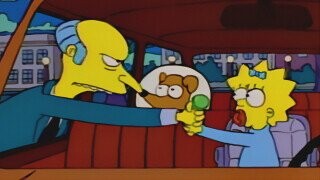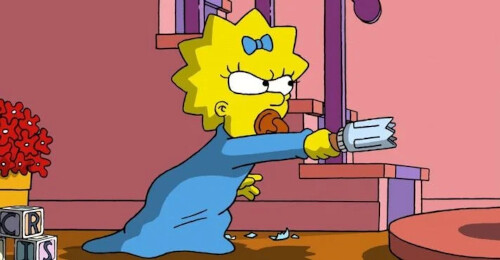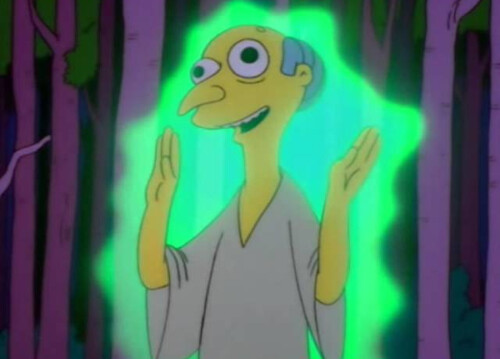Meet Springfield’s Most Evil Citizens: Mr. Burns And Maggie Simpson

It's no exaggeration to say that The Simpsons has influenced every writer you've ever read on this site (or any other comedy site). So this week, Cracked is taking a closer look at the town of Springfield and all of our favorite residents ...
If The Simpsons evoke feelings of '90s nostalgia for you, we invite you to enter to win one of three advanced copies of "The Nineties: A Book" by Chuck Klosterman, courtesy of Penguin Random House. Submit your email below to enter and learn more here.
Don't Miss
The pantheon of Simpsons characters is, to put it mildly, astounding. The cartoon’s roster of heroes and villains and Disco Stus is deep and daisy-chained, with a history and hierarchy rivaling that of the Greek gods. Some, like Mr. Burns, are integral and endlessly fascinating parts of the show. And others, like Maggie, are, y’know, just kind of there.
Maggie Simpson Is a One-Note Sociopath

The Walt Disney Company
Let’s just get this out of the way: Maggie Simpson is probably the most openly sociopathic character on The Simpsons. Bart gets all the glory, but he also gets the redemption arcs. He may shove his rude ‘tude in your face, but he’ll usually end up feeling bad about it, or paying a price. Maggie, meanwhile, has no such feelings. She may not have any feelings at all.
Maggie Simpson, the adorable perpetual baby, is prone to violent tendencies that put both Homer and Bart (and Fat Tony) to shame. She’s hit her father in the head with a mallet, fired a nail gun at him, pulled a rifle on mobsters, pulled a shotgun on Mr. Burns, and, of course, tried to murder that same old man over a lollipop. She’s made effigies of her nemesis solely to ruin them, and smashed a glass bottle and threatened a monkey. In “At Long Last Leave” she even intimidates a real estate agent who dares mention that Maggie might not be the most well-adjusted child out there. More recently, she took to becoming a mafioso a little too easily.

The Walt Disney Company
For a helpless toddler, Maggie Simpson is independent and hyper-competent to the point of not needing her family. She’s been seen changing her own diapers and driving a car. She’s bowled a perfect game at the ripe old age of 1. In fact, an entire story in “Midnight Towboy” is all about how Maggie doesn’t actually need anyone.
Of course, who can blame her for wanting to step out on her own? Her own family, with maybe the exception of Marge, tends to ignore her. Homer forgets her name all the time. In fact, in season seven’s “Home Sweet Homediddly-Dum-Doodily,” he even says “I wish I knew something about the baby I could miss.” No wonder that episode ends with Maggie seriously considering becoming a Flanders.
The show itself isn’t much better. Most Maggie-centric episodes just aren’t. Season five’s “Rosebud,” about Maggie refusing to give up Adolf Hitler’s teddy bear, is actually a Mr. Burns episode. “Moe Baby Blues” is about Moe’s battle with depression and purpose. Even “A Made Maggie,” that one where she became a mobster, was more about Fat Tony and Marge and Homer.
Perhaps the most famous Maggie episode, “And Maggie Makes Three,” takes place almost entirely in flashback to a time before she was born, all to explain why there are no pictures of her in the Simpson house. It ends with the reveal that Homer’s using her photos to alter a plaque to read “Do it for her.”

The Walt Disney Company
At best, Maggie Simpson is a cause, an idea. At worst, she’s an infant neglected to the point of preternatural independence. As a result, Maggie Simpson really doesn't have very much impact on the show, outside of the time she shot Mr. Burns, that is – another sociopath, but one that’s a lot more complicated and rewarding to watch.
So let’s talk about Mr. C. Montgomery Burns.
Monty Burns, Old, Weird, and Messy AF

The Walt Disney Company
Far from being a one-note villain, Mr. Burns is an ever-expanding character, someone who grows more and more complicated with every episode. Though he was originally a stock Evil Corporate Type, a plot point in a pleated suit, The Simpsons has added a, fittingly, ridiculous amount of depth and quirk to ol’ Monty.
This development started very early on, too: the fifth season’s “Rosebud” shows him cuddling up with his long-lost teddy bear, Bobo, a billionaire with a broken heart of gold. Almost a decade later, “A Hunka Hunka Burns in Love” dives in even furthers, and gives us a lonely old man longing for love and fighting a pile of his own insecurities around growing old and out of touch.
Which, given how anachronistically elderly Mr. Burns it, makes sense. He’s old, but, like, so old it’s impossible. It’s the stepping-on-a-rake joke for aging.
Let’s take a quick look at that chronology. He writes on parchment, occasionally with a quill, and seems to still believe in the Middle Age notion of fluid humors controlling the body. In season seven’s “Team Homer,” he gets high on ether, like it was the 1800s. There’s a 19th century woodcut of him terrorizing children. He references the Crimean War of the 1850s as something he remembers. He answers the phone with “Ahoy hoy,” like Alexander Graham Bell preached in 1876. His social security number is 2. Burns was already rich and hanging out with Babe Ruth during the Great Bambino’s heyday in the 1920s. He wants to wall up unionists in coke ovens, the kind that peaked in the 1910s. He’s even said to have dated Betsy Ross.
Even when we’re not being taken through a brief history of the world, Burns is prone to making up words that just kind of sound antiquated: numbskullery and picto-cube, velocitator and deceleratrix. He adds -ola to almost everything – bathiola, faxtrola – a reference to the Victrola phonograph from 1901. He speaks with exaggerated formality, saying things like “bumbled bee” and “iced cream.” He’s also apparently never had a credit card, referring to them as “charge plates” and “newfangled swipe-a-ma-jigs.”
Mr. Burns’ health is also a mess of nonsensical excess, beyond the ken of modern medicine and so hyperbolic that even the crankiest centenarian can’t take offense. He occasionally has difficulty lifting spoons, and routine has Smithers exercise for him. “The Mansion Family” christens him with “Three Stooges Syndrome,” a collection of maladies in perfect balance with one another, rendering him functionally immortal while also leaving him vulnerable to a slight breeze.
And then, of course, there’s “The Springfield Files,” which shows the assembly line of medical care Monty’s set up to cheat death for another day, while also explaining that he glows in the dark from a lifetime at the power plant.
Hell, even his evil has depth. Sure, he’s played chess with humans, bought up all of Springfield’s snow plows to play soccer, and there’s that one time he let Homer get raped by a panda, but he’s got a softer side, too. He’s risked his life to save others several times, freed Springfield Elementary from the clutches of an (even more) evil corporation, and, despite it all, genuinely cares for Smithers. Homer, Lenny, and Carl even once broke Burns out of prison because they missed having him as a boss.
In “The Old Man in the Lisa,” Mr. Burns tries to reform, working with Lisa Simpson to build a recycling plant, until, naturally, it’s revealed that he’s recycling sea creatures into slurry – seemingly clear evidence that he’s evil to his core. In “A Hunka Hunka Burns in Love,” however, he explains that, actually, he actively tries to be evil because it’s his brand. Monty Burns is very much aware of who he is and, more importantly, who Springfield – and The Simpsons – needs him to be.
‘The Simpsons’ Falls Apart Without Him

The Walt Disney Company
Mr. Burns was one of the first non-Simpsons on The Simpsons to step out into his own, to become an essential and fully-fleshed out character as opposed to some random joke or collection of outdated stereotypes. In the mobile game The Simpsons: Tapped Out – the only true barometer of these kinds of things – he’s one of the first characters unlocked, with a staggering thirteen different costumes to choose from. (As a point of reference, Maggie wasn’t even included until several years after the game debuted.)
Despite his atrocities, he’s a fan favorite – and a writer favorite, too. Conan O’Brien has gone on record saying that Monty was the greatest character to write for: “When you give a character unlimited wealth and unlimited cruelty, there’s no end to what they can have in their basement.”
In “Who Shot Mr. Burns,” writers Bill Oakley and Josh Weinstein took this sentiment even further, essentially making it Simpsons canon. Waylon Smithers refers to Monty as “unconscionably fiendish,” later explaining that he “crossed the line between everyday villainy and cartoonish supervillainy.” Smithers was appalled; the rest of Springfield was incensed to the point of violence – but the show’s writers have never looked back.
Mr. Burns sets entire plots in motion. He’s a goddamn chaos engine, the perpetual motion machine that’s let The Simpsons run for longer than some of you reading this have even been alive. There is literally nothing Montgomery Burns can’t do.
In “The Trouble With Trillions,” Monty steals a trillion-dollar bill, a last-minute idea pitched by a writer’s brother after the production team’s original idea proved untenable (they wanted Homer to use possible Native ancestry to get out of paying taxes, till they looked it up and realized Native Americans do pay taxes). In “Monty Can’t Buy Me Love,” he kidnaps the Loch Ness Monster and puts him to work in his casino. Want Mr. Burns to dig for oil? Sure. Inadvertently finance a monorail? Go for it! Own an opera house? Why the hell not! What about having him go full Cruella de Vil and singing an entire musical number about animal cruelty? Obviously yes.
Monty Burns is a villain to rally against – he’s Thanos or Voldemort. Immortal and all-powerful. He’s a reason for Lisa Simpson to get righteous, for Homer to stumble and “D’oh!” his way into accidentally being a hero. When Burns shows up, tenting his fingers and cackling “excellent,” you know shit is about to go down. Or not! Because if a Burns-centric episode becomes a surprisingly poetic The Great Gatsby parody, painting Burns as the victim of more modern billionaires, well, that’s just fine, too.
Hating Mr. Burns Has Become Quaint

The Walt Disney Company
That “The Great Phatsby” two-parter, originally aired in 2017, is representative of Mr. Burns’ growth and change over the decades, especially in a world where heartless billionaires are now the recipients of extensive hero worship. In the episodes, Jay G, owner of Golden Goose Records, manages to steal Burns’ entire fortune, using tactics he learned from the nuclear-power proliferator. Burns himself is painted as a sympathetic victim, outgunned, outclassed, and utterly out-of-touch with the cutthroat realities of modern capitalism.
2008’s “The Burns and the Bees” similarly showcases Mr. Burns falling behind, both financially and culturally. At Billionaire Camp, Monty is surrounded by real-life tycoons who have no patience for him. Guest-starring as himself, Mark Cuban lampoons his own image and self-importance, while Burns tries to mimic the Mavericks owner’s outsized personality as a way to stay relevant. It doesn’t work, and the billionaires toss the old man over a fence, into the much crappier Millionaires Camp, effectively shunning him and shutting him out of their prestigious social tier.
The eternal villain, cackling and (metaphorically) twirling his mustache, has become a sympathetic figure. Mr. Burns is, decades in, a friend to Homer and the Simpsons in many ways, despite the earliest episodes and all the various attempted murders each has sprung on the other. Not necessarily because he’s gotten better, but because the world has gotten worse and a simple nuclear power plant owner just can’t keep up.

The Walt Disney Company
C. Montgomery Burns is a scion of the past, an outdated kind of malignancy – and hating him has become almost comforting. He’s a Scooby-Doo villain, complete with booby-traps and easily foiled by meddling kids. He’s an industrialist and a robber baron, two centuries too late. An evil that’s easily triumphed by good.
Take “Last Exit to Springfield,” for example. After not getting what he wants, Mr. Burns shuts off electricity to the whole of Springfield. A single protest spurs him to stop. Led by Lisa, the town’s residents simply refuse to back down, and Burns has a change of heart, complete with a Grinch-like rhyme.
As simply existing through 2016 and onward has taught us, that’s not how things work. It’s adorable how “evil” and “terrible” and “scary” Mr. Burns is, compared to the complex and transcendentally irrational monsters currently making up our elite-o-sphere. The Zuckerbergs profiting on disinformation while promising a brand-new future, the Trumps who not only refuse to listen to reason, but to even acknowledge that reason is a thing.
While The Simpsons as a whole seems mired in a vague and all-purpose contrarianism that most of the rest of Gen X has grown out of, the show does seem to know, on some level, that the world is passing them by. Even if it does only manifest as a wistfulness for a time when villainy could be fun and easy.
It’s unlikely, of course, that all of that is directly related to the increased fame and adoration of tax-dodging a-holes like Elon Musk and Steve Jobs, the cults of rabid fanboys that have sprung up around them (something The Simpsons has certainly been guilty of itself.) Stories and characters simply evolve with time, and thirty-plus years will change anyone – except, obviously, for stupid baby Maggie Simpson.
Eirik Gumeny is the author of the Exponential Apocalypse series, a five-book saga of slacker superheroes, fart jokes, and assorted B-movie monsters, and he recently added werewolves and assassins to The Great Gatsby. He’s on Twitter a bunch, too.
